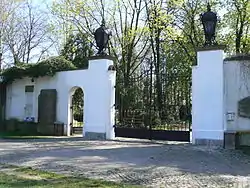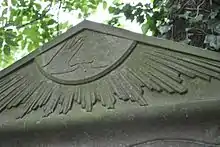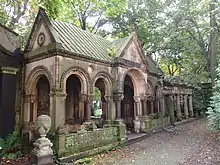Old Jewish Cemetery, Wrocław
The Old Jewish Cemetery (Polish: Stary Cmentarz Żydowski we Wrocławiu) is a historic necropolis-museum situated on 37/39 Ślężna Street, in the southern part of Wrocław (formerly Breslau), Poland. Opened in 1856, the cemetery's eclectic layout features many architectural forms and styles on a monumental scale.[2]
 Entrance gate | |
| Details | |
|---|---|
| Established | November 1856 |
| Location | 37/39 Ślężna Street, Wrocław |
| Country | Poland |
| Coordinates | 51°05′12″N 17°01′30″E |
| Type | Jewish cemetery |
| Owned by | City Museum of Wrocław |
| Size | 4,6 ha |
| No. of graves | Approximately 12,000[1] |


The current shape of the cemetery evolved mostly throughout the 19th century, during the times of the German Empire. The first burial took place in what was then the village of Gabitz (Gajowice), just outside city limits. The cemetery area was then expanded twice. In 1943, the burial ceremonies were abandoned and the necropolis was leased for five years to a gardening center. During World War II, the cemetery became a fierce battleground, the marks of which are still visible on many tombstones. It was inscribed into the register of city monuments in 1975.
Architecture
Most of the cemetery objects were built in second half of the 19th century. They imitate various architectural styles including Ancient, the Middle Ages, Renaissance, Baroque. Great example of Ancient architecture are numerous columns located throughout the cemetery that are symbols of life and eternity. Columns imitating broken trees reflect the tragedy of fragile life and death. Tombstones are signed by bilingual inscriptions, most commonly German and Jewish.[3]
Most common symbols of Jewish culture which can be seen on tombstones are:
Renowned people buried at the cemetery
- Isidor and Neander Alexander - renowned banker family[3]
- Leopold Auerbach - professor in biology and history at the University of Breslau (now University of Wrocław)
- Julius Cohn - professor of botanics
- Heinrich Graetz - professor of history at Wrocław University
- Friederike Kempner - writer
- Ferdinand Lassalle - a thinker, labor leader, and social activist who stayed in close contact with Karl Marx and Friedrich Engels
Antisemitic incident
On July 30, 2010, the Jewish cemetery in Wrocław was desecrated with swastikas drawings and vulgar graffiti. In addition, some of the gravestones were broken.[4]
Picture gallery
 Helmet motif
Helmet motif Leopold Aucherbach tombstone
Leopold Aucherbach tombstone Oriental tree symbol
Oriental tree symbol Tombstone destroyed during World War II
Tombstone destroyed during World War II.JPG.webp) Exotic interior of a mausoleum
Exotic interior of a mausoleum Broken tree
Broken tree
References
| Wikimedia Commons has media related to Wrocław Old Jewish Cemetery. |
- "Spacer dla seniorów po Starym Cmentarzu Żydowskim". VisitWroclaw.eu.
- "Stary Cmentarz Żydowski przy ul. Ślężnej". www.wroclaw.pl.
- Łagiewski, Maciej. Stary Cmentarz Żydowski we Wrocławiu. Via Nova.
- "Poland - Jewish cemetery desecrated". CFCA. CFCA. Retrieved 5 December 2013.